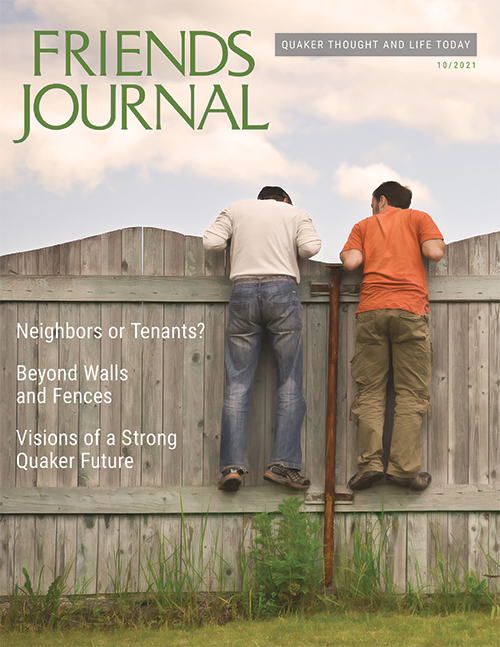How Do We Build a Religious Society That’s Creative, Relevant, and Thriving in 30 Years?
As Friends, we are called to be imaginative and brave in envisioning the future. Don McCormick (FJ Feb. 2018) asked us: “Why is there no vision for the future of Quakerism?” He offered several starting points. Ann Jerome wrote “Selling Out to Niceness” (FJ Sept. 2019) and described our urgent need for renewal. She called us to step into our witness in the world.
Cai Quirk and Alison Kirkegaard (FJ Feb. 2021) then asked us: “What could happen if we modern Friends embrace the heat of the transformative fire amongst us today?” They challenged us to welcome the heat of that fire. As Michael Sperger (FJ Aug. 2021) noted, “We seem convinced as a group that Quakerism is doomed to fade away.” However, “in every moment, the future contains a range of possible outcomes.”
We are at a crossroads. It is time to gather our creative power, admit the truth, and reinvent ourselves. We have the energy and ability to be thriving in 30 years. We need to form a collaborative vision and work intentionally toward our goal.
The Listening Project
The Listening Project (forwardinfaithfulness.org/listening) is a series of creative conversations rooted in love. JT Dorr-Bremme and I began holding listening sessions in 2020. We meet via Zoom and hold worship sharing. We’ve met with nearly 30 Friends from seven yearly meetings. We have found ourselves inspired, troubled, and altered by the stories shared.
While listening, we learned that the gifts of many younger Friends are blocked by the Quaker structure. (By “younger,” we typically mean Friends under the age of 55.) As we shared these findings with the wider community, some Friends expressed grief at our findings. Several older Friends had no idea that younger folks were running into barriers. Younger Friends shared relief to learn they were not alone in their experiences. There is certainly a generation gap in our community: some truths are easily buried or hidden from sight.
At Pacific Yearly Meeting annual sessions last year, Mica Estrada reminded us:
If we really want to be radically inclusive, we will have to surrender and let go of what is precious to us—perhaps power, perhaps things that make us feel comfortable, that make us feel safe in the world.
The path to spiritual renewal will involve some tough sacrifices. However, if we move in faith, then we will have all that we need.

Illustration by artinspiring.
Sources of Blockage
Sharing our findings across generations requires some delicate translating. The truth may be alarming to some Friends, while encouraging to others.
In many parts of the United States, Quakers are saying and doing things that directly contribute to our own decline. If we want to be creative, relevant, and thriving in 30 years, we need to address these behaviors and take an honest look at our structures. How well do they meet the needs of the whole community?
The behaviors that block us include: conflict avoidance, politeness, gatekeeping, giving advice, and being dismissive. A number of Friends named these behaviors in listening sessions; they are not isolated trends. The blockage affects everyone, but it impacts Friends under 55 and newcomers in particular. Participating in a community is both distressing and fatiguing when these behaviors show up.
These behaviors stem from societal pressures in the United States, including age segregation, capitalism, competition for control, ageism, racism, and a tough generational transition. Quakers like to say that we are “in the world but not of it.” This axiom, however, overlooks the fact that we are influenced by societal pressures and norms, just like everyone else.
If we want Spirit to flow freely, we need to address our behaviors and their root causes. For now, I will focus on three barriers: age segregation, ageism, and giving advice. I will share quotes from participants in the Listening Project. Some people are quoted anonymously, others with names attached, according to their preference.
When we assume that young people want separate spaces, we lose opportunities to collaborate. We also shrink the depth and vibrancy of our community.
Age Segregation
Older and younger Quakers tend to have very different experiences with the following: U.S. institutions, Quaker structure, job security, geographic mobility, and being heard inside their Quaker community. Age segregation constricts our ability to reach each other across this gap. It prevents us from showing up meaningfully for one another.
Often, we create age-specific groups with good intent. For example, young adult Friends (YAFs) can attend YAF programs and meet with their peers. Unfortunately, some YAF programs are scheduled at the same time as other Quaker programs. One participant from the Listening Project, Analea Blackburn, described the barriers that this creates. When she was 16, Blackburn wanted to attend business meeting at annual sessions. However, the schedule wasn’t set up for youth to easily attend. “I was a clerk for my age group,” she said, “so I had to stay in JYM [Junior Yearly Meeting] in the morning. I had to choose between being a clerk for the day or going to business meeting.” The structure blocked her from participating. If JYM had ended 30 minutes earlier, she could have attended the adult business meeting.
A second Friend echoed this perspective. In his yearly meeting, as well, younger Friends are often set apart from older Friends. He notes: “Our community, structures, clerks, and business meetings were separate.” When asked to co-clerk this YAF group, he felt torn. He reports wanting to be “in the big tent” with the larger community, but finding it difficult to turn down an opportunity to use his gifts. Leadership within his age group meant sacrificing his participation in the wider body.
When we assume that young people want separate spaces, we lose opportunities to collaborate. We also shrink the depth and vibrancy of our community. One participant from the Listening Project, Melinda Wenner Bradley, told us: “I don’t want to belong to the Religious Society of Grown-ups. We have a different community if it’s only adults and no one who grew up in our tradition. What is lost when there are no more children and teens—and the adults they grow into?” Her words speak to the grief that many meetings feel when they reach a point of having no children. “Unless we pay more attention to children and young people and their parents,” she asked, “what does the future hold for us?”
Integration and vibrance takes careful attention. Emily Provance, a Quaker minister, offers several resources for age integration on her blog, Turning, Turning. One 2017 essay, “What Multiage Inclusion Might Look Like,” pinpoints cultural barriers in the Quaker world and reimagines them transformed.
We can also assess our schedules at yearly meeting and other gatherings. What would younger Friends be blocked from attending because of conflicting schedules? I’d recommend asking young folks if they want to attend these events, and restructuring if needed. Though event planners cannot please everyone, this labor supports our mutual healing.

Illustration by artinspiring.
Ageism
Ageism, which includes a range of dismissive behaviors, is present in our Quaker community. JT and I heard from many Friends under 40 who reported feeling that their voices were not valued in Quaker spaces. This was unfortunate news to hear. One teen told us: “I feel like I can’t really speak my mind.” This Friend was referring to conflict aversion, yet their feelings were shared by others. Another teen said: “I love being a Quaker. I feel very connected to the Quaker community. But I do wish that I was more included, because right now it feels like an uphill struggle to have my voice heard.”
Like racism, ageism hampers our ability to live out true equality. A Friend in her 40s described some of the blind spots present in her community. She started attending Quaker meeting when she was 25. “I had a bachelor’s and a master’s degree, and I’d been in the Peace Corps. I was working full-time; I saw myself as an adult. It took me a while to realize that I was seen as a young adult by my meeting.” Several other Friends have echoed this sentiment in conversation. An older Friend once told me: “I never thought of myself as a junior adult.” In light of this feedback, JT and I have begun using the phrase “Friends under 55” to describe our peers.
Combating ageism requires that we face difficult truths: Quakers can be slow to meet the needs of Friends under 55. This includes parents, children, millennials, and Generation Xers. In listening sessions, many Friends under 55 described being on the fringe of their community. Often, Quaker groups can prioritize the needs, preferences, and voices of older Friends over the needs of younger Friends.
We may need to examine how our communities operate. Whose needs are not being met? What are the unmet needs? In a listening session, Melinda Wenner Bradley noted that Friends can be quite adaptable in their efforts to welcome all people. However, Quakers are much more likely to rearrange things for an older Friend than a younger Friend. “I’ve never heard someone say, ‘There’s a six year old, who really needs X in order to participate.’ Those are words I’ve never heard.” If we want to grow, we need to meet the needs of parents and children.
Deep within, we yearn to be all together, even if we are blocked by certain barriers at times. We have tough work ahead of us, but we are well-equipped with knowledge and strong hearts. We can work collaboratively in the present.
Giving Advice
In our research, many teens report that they are receiving unwanted advice from adults rather than simple listening. When a teen shares about a life decision or circumstance, adults may interject with suggestions. This trend does not represent every adult, or every instance, but it is a noticeable pattern. This form of ageism creates frustrating barriers.
I have noticed this trend in my own life. I often find it easy to offer advice when I’m speaking with someone younger than me. Reflexively, I may be thinking, “This person is in distress. Surely I have some life experience that could help them!” I can forget to ask the person whether they actually want advice. When listening, I am more likely to lapse into offering solutions if the speaker is younger than I am.
With introspection, we can assess our individual patterns. How often do I give suggestions? When I offer advice, is it warranted? What motivates my behavior? These queries can guide our interactions. As my Al-Anon program reminds me, our goal is to give others “the dignity to live out their own consequences.”
In addition, we can build structures that encourage deep listening. New York Yearly Meeting launched a mentorship program that supports intergenerational friendship; Friends General Conference is beginning a similar program that starts this fall. Last January, Pacific Yearly Meeting invited younger Friends to speak to a round table of older Friends. In June, Friends in Philadelphia Yearly Meeting brainstormed about the future of Quakerism as part of their annual sessions. All of these efforts contribute to cultural change.
Some solutions are emerging outside of traditional boundaries. While exploring and brainstorming in a listening session, JT and I considered the idea of holding clearness committees with teens. A teen could bring their question forward, inviting older and younger Friends to join them in discernment. Friends across ages would have a clear reason to connect with a spiritual goal. With practice, older Friends seeking clearness could invite teenagers to accompany them on the journey as well. Teens could hold space and offer listening. This exchange would open new moments of witness.
Wouldn’t that be a radical change? We could accompany each other in ways that are relevant, loving, and grounded. JT and I are still developing this idea. We will post resources on our website (forwardinfaithfulness.org).
Radical Change
To build a strong Quaker future, younger Friends are calling us into radical equality. We can rise to that call. “As young adults,” Analea Blackburn said, “we don’t want to take over the meeting. We don’t want to suppress the voices of older Friends. But we want to be on the same level and respected in the same way. And I think that means changing the fundamental culture of Quakerism as we know it.”
To provide spiritual nourishment, we may need to shed excess structure. Last summer, Callid Keefe-Perry spoke to Friends at Three Rivers, a worship group that is radically reclaiming our faith. He asked: “Are we following the Power? Are we seeking life and life more abundant? Some practices might not be deadly, but they might not be life-giving. We need to move toward the Life.” What an invitation!

Illustration by Bro Vector.
Vision for the Future
This is the time to gather creative ideas and clarify our vision for the future. We can admit the truth. We can experiment, harnessing our collective power.
One vision of the future emerged during a listening session, and I’d like to share it here. Melinda Wenner Bradley described a powerful experience of unity in worship. While traveling, she felt something rise in her when the children returned to worship. As they trickled in, she felt and heard the message, “Now we’re all here.” It was a deep and riveting moment. Wenner Bradley says:
That has become like a prayer that rises in me whenever I’m in a place and the children join us in worship. “Now we’re all here.” When we prepare the space and ourselves for all-ages community worship, those times are grounded and joyful. Community worship is gentle and filled with Light. It’s not jumping-around joy. Actually, what it really is, is being filled with love.
May we open ourselves to be filled with that love. Deep within, we yearn to be all together, even if we are blocked by certain barriers at times. We have tough work ahead of us, but we are well-equipped with knowledge and strong hearts. We can work collaboratively in the present.
Thank you to Analea Blackburn, Melinda Wenner Bradley, and Robin Ertl, who provided feedback on this article.




The statement “The truth may be alarming….” throws your entire article into doubt. You have no idea if what you think is the truth actually is the truth. It is alarming that you believe that it is, and more alarming that you present it as such. Perhaps “The information we present may be alarming..” might be more accurate.
.Be very, very, careful of using the universal “we”; such usage has become all too common in the speech and writing of Quakers. Statements that begin with “We need…” or “We ought…” are usually incorrect. No one can speak for all Quakers.
And then there is racism, which at 15th street means that Friends welcome some people who come to meeting and not others. Friends invite some newcomers and not others to social hours and committee and business meetings.
And then there is classism, for we are schooled, professionally working, educatedly speaking, and quietly dressed. Others stand out.
And then there is the fact that New York City meetings are mostly about money and property. No prestige any more. Speaking in meeting seems to involve all the great wisdom I have to share with others. Testimonies have more to do with history than with the present. Since Covid-19 shut down a night shelter for 15 people, closed the meeting house for AA and two other church groups, and separately incorporated the Friends’ Seminary elementary-through-high-school, being a Friend at 15th street has had only to do with Zoom meetings and talking, but not doing anything, about social issues.
And then there is language, specifically Friends’ use of certain words – possibly different in each Friends’ meeting – to describe what we are, or wish we were, doing. It shows up in introductory handbills about Friends that put history and jargon together and give newcomers no reason to return to meeting.
Reader John Maynard points out many of the cultural problems that are present in the Religious Society of Friends. These include racism, classism, and a consolidation of power, as well as the barriers described in my article. Addressing barriers is urgent and important work! In writing for Friends Journal, I needed to let go of several meaningful topics in order to share about only a specific few.
Fortunately, other Friends out in the world can speak more directly to John’s concerns. These include:
— Ayesha Imani’s QuakerSpeak video, “How Does Culture Influence Quaker Worship?”
— Lisa Graustein’s article, “Noticing Patterns of Oppression and Faithfulness” (FJ, Feb 2020)
— Don McCormick’s interview with George Lakey, “The Middle Class Capture of Quakerism and Quaker Process” (FJ, Oct 2020)
All four of these Friends (four, since Don McCormick’s article draws heavily on wisdom from George Lakey) have helped me get clear on the kind of Quakerism I want to see in the future. They motivate me to change my life in subtle ways as I begin to work toward that future. Prophetic voices like these sometimes make me uncomfortable. However, they call me into the fullness of life.
Additional resources I would recommend include:
— FGC’s resources on challenging racism
https://www.fgcquaker.org/resource-type/challenging-racism
— New England Yearly Meeting’s resources on Inclusion in our Meetings
https://neym.org/inclusion-our-meetings
— Carlos Valentin’s vocal ministry on complacency in Western Friend
https://westernfriend.org/complacency
And on a final note, I think many Quakers can agree that no one article can cover every cultural problem present for liberal, unprogrammed Friends in a satisfying way. (If it did, I doubt that the article would fit inside the word limit for Friends Journal. It would probably be written by many people, revised continuously, grow longer than the Lord of the Rings series, and still be contentious.) However, I trust that in writing from my perspective, other people will rise and contribute their voices over time.
And sit together in silence.
I agree with George Hebben about the importance of careful speech and avoiding generalizations. However, it is not possible to do the work that I am called to do, some of which is advocacy, without speaking somewhat to the overall picture. In writing this article, I decided to offer difficult truths that had been shared with JT and me. Some of my work in the Quaker community is about pointing out the prevalence of these patterns.
After reading George’s comment, I took a look at the use of the word ‘we’ in the article. I wondered: what would it be like if those statements were not true? Could some of them be untrue? I came up with a list of converse statements, some of which I will share here:
— Perhaps Quakers are not called to be imaginative and brave in the future.
— Maybe there are Friends who do not yearn to be together, or who feel they do not have strong hearts and knowledge.
— Maybe there are those among us who are unable to rise to the call of radical equality.
These statements may be true in some cases; however, they seem to undersell our potential as a group. A question I have remaining for George is this: What part(s) of the article conflict with your personal experience of Truth? What do you envision for a strong Quaker future? That is what I am really curious about.
Thank you for your article, Johanna. I wonder how the doomsday Quakerism attitude is akin to our desperation of climate change/extinction? Many Black science fiction authors invite us to imagine a future beyond the present we currently know. There is so much despair and fear in our present- yet what if we do imagine what the future could be, and steward that into being as we’re best able?